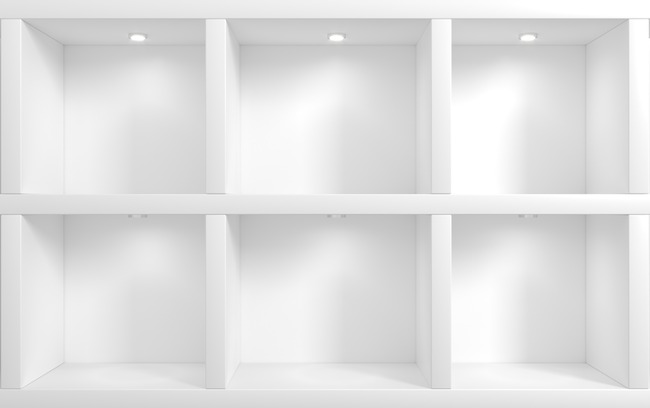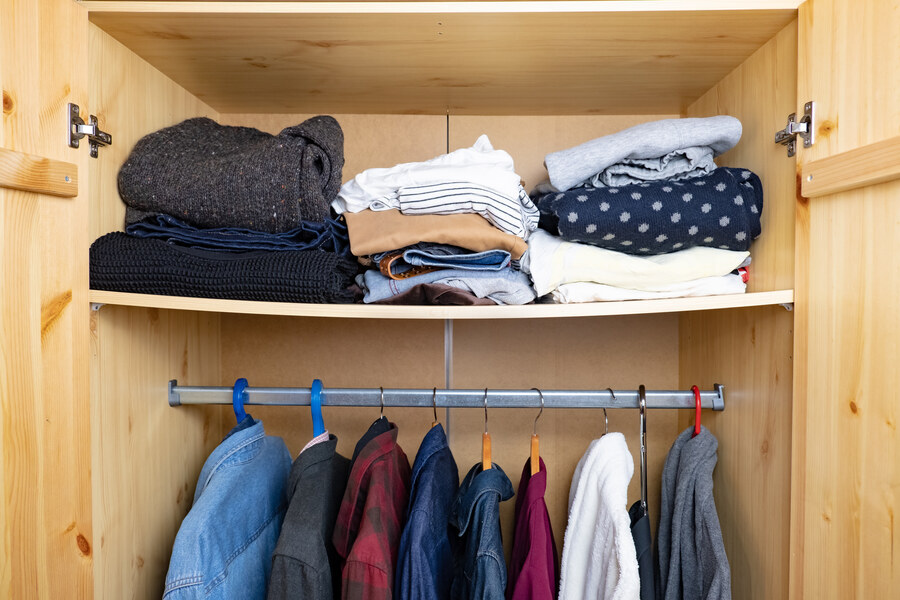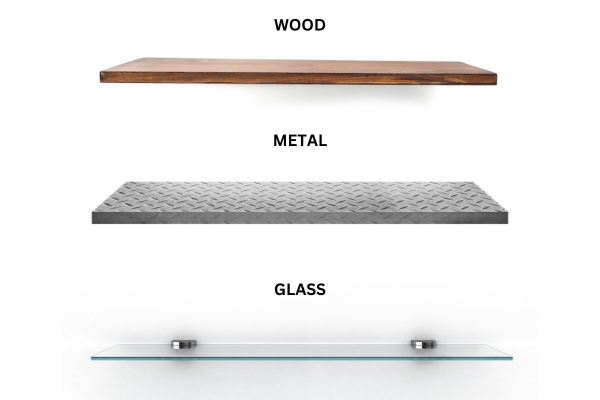Posted by Wall Panels World on 23rd May 2025
MDF Shelves & Shelf Boards | Structural Integrity & Suitability
MDF shelves offer a practical middle ground between cost and performance. Made from compressed wood fibres and resin, MDF provides a smooth, consistent surface that works well in many shelving applications, though understanding its characteristics helps ensure the right choice for your project.
Note: This guide provides an independent assessment of MDF shelving, including both advantages and limitations to help you make informed decisions.

What is MDF?
Medium-density fibreboard (MDF) is an engineered wood product made from wood fibres bonded with resin under heat and pressure. The manufacturing process creates a uniform, dense material that's smoother and more consistent than natural wood, without knots, grain variation, or the directional strength properties of timber.
For shelving, MDF offers several practical advantages: it's dimensionally stable (won't warp like solid wood might), cuts cleanly without splintering, and provides an excellent base for paint or veneer. The fibres are oriented randomly throughout the board, giving fairly consistent strength in all directions.
High-density MDF (above 800kg/m³) offers better structural integrity for shelving applications compared to standard grades. Quality matters more than thickness alone when it comes to preventing sag over time.
The key limitation is moisture sensitivity. MDF readily absorbs water, which causes swelling, warping, and potential delamination. This characteristic significantly influences where and how it should be used for shelving.
How MDF compares to other shelf materials
Each common shelving material has characteristics that suit different applications and budgets:
"MDF can work well for the right applications, but you need to understand its limitations. For painted built-ins on a budget, it's cost-effective for low-load, low-moisture areas when properly supported and sealed."
— Jacob Rhodes, Owner and Chief Engineer at TrueTrac
When MDF works well for shelving
MDF performs effectively in specific shelving scenarios where its characteristics align with the requirements:
Painted shelving projects
The smooth, uniform surface of MDF accepts paint exceptionally well, making it ideal for built-in shelving that will be painted to match walls or trim. Unlike natural wood, there's no grain telegraphing through the paint finish, and no knots that might bleed through over time.
Alcove shelving
Built-in alcove shelves benefit from MDF's stability and paintability. These applications typically involve shorter spans with good support from the alcove sides, playing to MDF's strengths.
The consistent thickness and straight edges simplify installation, and the painted finish creates a seamless look with surrounding walls.

Light to medium storage loads
For books, decorative items, and general household storage, properly supported MDF shelves perform adequately. The key is matching thickness to span and load requirements.
- 15-18mm thickness: Books and light decorative items up to 600mm spans
- 18-25mm thickness: Medium loads including kitchenware up to 700mm spans
- 25mm+ thickness: Heavier items but still requiring adequate bracket support
Display and storage applications
MDF shelving works particularly well for organised storage and display applications where the clean, painted finish complements the room's design.

Indoor, dry environments
MDF shelves work best in climate-controlled indoor spaces with stable humidity. Living rooms, bedrooms, and home offices provide suitable environments when properly sealed and finished.
"Limit MDF spans to 600mm and add hardwood edge or metal support. Seal all sides with paint or laminate for the best results."
— Jacob Rhodes, TrueTrac
Thickness and load capacity guidelines
Understanding the relationship between MDF thickness, span length, and load capacity helps prevent sagging and ensures long-term performance.
| Thickness | Recommended Span | Typical Load | Best Applications |
|---|---|---|---|
| 15mm | Up to 500mm | Light items (10-15kg) | Display shelves, small bookcases |
| 18mm | Up to 600mm | Books, decor (15-20kg) | General shelving, alcoves |
| 25mm | Up to 700mm | Medium loads (20-30kg) | Kitchen shelves, media storage |
These guidelines assume proper support at the recommended intervals. Adding centre supports or reducing spans can increase load capacity, while exposure to moisture or poor-quality MDF will reduce performance.
Preventing sag
Several approaches help minimise sagging in MDF shelves. When inadequate support is provided, even relatively light loads can cause permanent sagging over time:

Use adequate thickness for the span and load requirements
Add centre supports for spans exceeding recommended limits
Consider a hardwood lipping on the front edge for added rigidity
Use wall cleats for continuous support along the shelf length
Edge profiles and finishing options
The edge profile affects both the appearance and practicality of MDF shelves. Different profiles suit various applications and design styles.
Sealing and finishing
Proper sealing is essential for MDF shelf longevity, particularly at the edges where the material is most porous:
- Apply MDF-specific primer to all surfaces, paying extra attention to cut edges
- Use high-quality paint or clear sealant rated for interior woodwork
- Sand lightly between coats for a smooth finish
- Consider edge banding for a professional appearance on visible edges
Installation considerations
Support requirements
MDF's characteristics require specific consideration for bracket placement and wall fixing:
- Bracket spacing: Place supports at maximum 600mm intervals for 18mm MDF
- Wall fixings: Use appropriate wall plugs rated for the total shelf load
- Screw placement: Pre-drill holes to prevent splitting, especially near edges
- Weight distribution: Avoid concentrating heavy items at the centre of spans
Common installation mistakes
Inadequate support spacing
Placing brackets too far apart leads to sagging over time. Follow manufacturer guidelines and err on the side of additional support for peace of mind.
Poor edge sealing
Unsealed cut edges readily absorb moisture, leading to swelling and paint failure. Always seal all surfaces, especially where the shelf has been cut to size.
Overloading
Exceeding recommended load limits causes permanent sagging. Consider the cumulative weight of items over the shelf's entire span, not just individual heavy items.
Where to avoid MDF shelves
Certain environments pose challenges for MDF shelving:
- Bathrooms and wet areas: High humidity causes swelling and potential failure
- Unheated spaces: Condensation from temperature changes can damage unsealed edges
- Heavy-duty storage: Workshop or garage shelving benefits from stronger materials
- Long spans: Consider plywood or solid wood for shelves exceeding 800mm without centre support
Alternative shelf materials
When MDF doesn't suit the application, metal and glass shelving offer different characteristics for specific requirements:

Metal shelving
Steel and aluminium shelves excel in strength and durability. Powder-coated steel resists corrosion while offering exceptional load capacity, making it ideal for workshops, garages, and commercial applications. Stainless steel suits kitchens and bathrooms where hygiene and moisture resistance are paramount.
Metal shelving systems often provide adjustable heights and can support considerably more weight than wood-based materials. The main limitations are cost and the industrial appearance, though modern designs offer more refined aesthetics.
Glass shelving
Tempered glass shelves create a clean, contemporary look while allowing light to pass through, making spaces feel more open. They're particularly popular in bathrooms, display cabinets, and modern interiors where visual lightness is desired.
Glass shelves require careful consideration of load limits and span requirements. While strong when properly supported, they're less forgiving than other materials and require professional installation for safety compliance.
Making the right choice
MDF shelves work well when their characteristics match the application requirements. For painted built-in shelving in dry indoor environments with appropriate support, they offer an economical solution with excellent finish quality.
The key lies in honest assessment of the intended use. Light to medium loads in climate-controlled spaces suit MDF's capabilities, while heavy-duty or moisture-prone applications benefit from alternative materials.
When properly specified, installed, and finished, MDF shelves provide years of reliable service. Understanding the material's characteristics ensures realistic expectations and successful results.
Ready to explore MDF shelving options?
Browse our range of MDF shelf boards with various edge profiles and custom sizing options to suit your project needs. Order samples to see and feel the quality before you buy.


